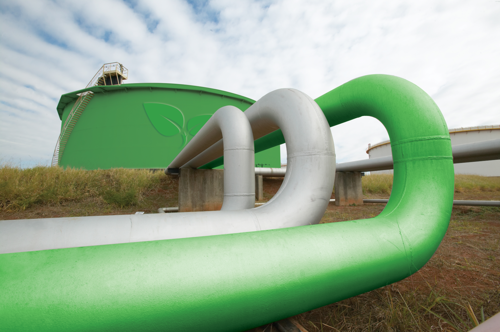2021 AFPM Annual Meeting Virtual Edition: Strategies for renewable diesel plant success
MARCELO CARUGO, Vice President, Global Refining and Chemical, Emerson Automation Solutions; and JULIE VALENTINE, Director, Global Refining Measurement Solutions, Emerson
Sustainability trends are key drivers for the expanded use of vegetable oils, used cooking oils, animal fats and other alternative feedstocks for many refineries.
While this trend is taking flight in an effort to reduce our carbon footprint by reducing emissions, it is also important to enhance safety, reliability and maximize profitability in renewable plants (FIG. 1). Renewable processes can create challenges from relatively severe operating conditions, corrosion, high variability in feed quality, as well as validated flow accuracy and regulatory reporting—making the need for process optimization crucial.

FIG. 1. The addition of a renewable diesel plant provides the opportunity the examine data management and analytics technologies that will allow refineries to gain competitive advantage and achieve operating and business objectives.
It is helpful to note that renewable diesel units have several commonalities with traditional refinery operating units in the core reaction section, which is similar to hydroprocessing and isomerization units. However, there are two areas where most renewable diesel projects are different and require additional consideration when planning for operational optimization. The first is the outside battery limits (OSBL) section and the second is the feed pretreatment section of the plant. Even within the reaction section, unique challenges must be addressed.
The OSBL section requires reliable measurement technology. The OSBL section of the plant includes the handling and custody transfer of both incoming feedstocks and products leaving the plant. The logistics vary compared to traditional refining. As opposed to materials coming in and out of the plant primarily via ship or pipeline, the plant uses railcars or trucks for unloading feedstock and the loading of finished products. Because feedstocks can be variable in their physical properties, careful consideration must be given to choose the most appropriate measurement technologies for custody transfer operations and inventory tracking.
Another unique attribute related to the OSBL section of the plant is the requirement for accurate and verifiable measurement and accounting of not only the primary feedstocks and products, but also all of the utilities, chemicals, hydrogen, fuel gas, natural gas and electricity usage. This is necessary and important for obtaining the proper credits and must be considered in the design of the systems.
Feed pretreatment is another important step. A number of contaminants in bio-based feedstocks are not present in petroleum-based feedstocks, and these must be eliminated to protect the life of the hydroprocessing and isomerization catalysts used downstream. The amount and type of feed pretreatment depends on the type of feedstock processed. Treatment for the feedstocks will be more similar to food and beverage processes than they are to traditional refining processes. This can include drying, polyethylene removal, filtration, enzymatic degumming, chemical dosing and bleaching. Many of the reactions require stoichiometric ratios, mass-based reactions and concentration measurements for acids and caustic. Considerations for measurement technology choices are again important to ensure effective operations.
Minimizing corrosion can reduce safety risk. Corrosion is another challenge that should be addressed upfront in the plant design. Renewable diesel plants have corrosion issues similar to hydrotreating and isomerization plants in traditional refineries, with special attention required for amine units, air coolers upstream of separators and overhead systems in the fractionators. Feedstocks with higher values of fatty acids will tend to have more corrosion issues.
Also, renewable diesel plants produce carbon dioxide (CO2) and water in much higher concentrations than normal refinery units, causing carbonic acid to form, which leads to more corrosion downstream of the reactor. Wastewater produced from the plant can also contain high levels of carbonic acid, leading to additional corrosion in the wastewater system. Proper metallurgy for valves and instruments must be considered, and a corrosion monitoring process should be put in place. This can be successfully implemented through a combination of cost-effective, non-intrusive wireless corrosion monitoring technologies and corrosivity probes designed to enhance your processing safety and protect your plant.
Optimize the reaction section with the right instrumentation and valves. Even within the reaction section of the plant—which bears many similarities to traditional refining processes—additional consideration to instrument and valve selections is important. The highly exothermic reactions combined with the variability in the feedstocks present challenges to measurement and control schemes, which is why special attention must be given to ensure that optimum charge rates, purge rates and recycle ratios meet targets.
Digital transformation is the key to success. Finally, as most refineries are considering their digital transformation strategies, the addition of a renewable diesel plant—either as an extension of an existing petroleum-based refinery or as a standalone facility—provides the opportunity to examine data management and analytics technologies that will allow refineries to gain competitive advantage and achieve operating and business objectives. By making data available to all who can benefit from it, plant managers can impact positive change that enables peak performance through advanced analytics and actionable response.
Emerson delivers digital, wireless and advanced measurement solutions specially designed to optimize operations across all areas of renewable diesel plants, helping refiners build a more sustainable future for the industry, while optimizing reliability and enhancing production and safety.
About the authors:
MARCELO CARUGO is Vice President, Global Refining and Chemical, for Emerson Automation Solutions. He works with downstream manufacturers globally to create a clear and actionable path to operational excellence and digital transformation through applications of automation technologies. He joined Emerson in 1998 and has more than 30 years of experience in the chemical and refining process control industries, both domestically and internationally. Carugo received an electronic engineering degree from the University of Buenos Aires, Argentina; a post graduate diploma in electronic engineering from PIITS in The Netherlands; and a master of electronic engineering with honors from NUFFIC, also in The Netherlands.

JULIE VALENTINE is the Director of Global Refining Measurement Solutions for Emerson. She first joined Emerson in 1993, and has held various roles in the organization, always in support of technologies utilized in the refining and petrochemical industries. Valentine has authored numerous technical papers on various applications of flow technology in the refining industry, and is a co-inventor of two U.S. patents. She is a member of several working committees for the instrumentation and control group of API’s Refining and Equipment Standards Program, AIChE and various Women in Engineering and STEM programs. Valentine is a graduate of the Colorado School of Mines in Golden, Colorado with a BS degree in chemical and petroleum refining engineering. Before joining Emerson, she worked for a process licensor, primarily in the technical services group, where she was involved in the commissioning, startup and troubleshooting of refining and petrochemical process units around the world.







Comments